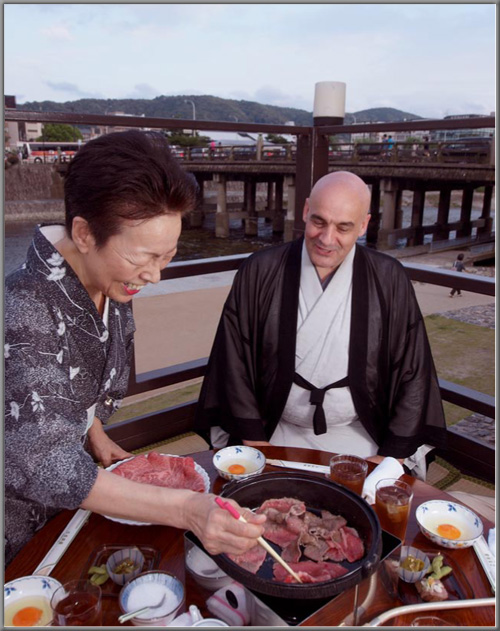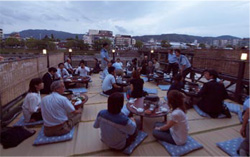Home > Highlighting JAPAN > Highlighting Japan JULY 2011 > Subtle Ways to Beat the Heat
Highlighting JAPAN
ENJOYING SUMMER IN JAPAN

Caption: Randy Channell shares a laugh with an attendant at Komai-tei as she prepares sukiyaki
on the restaurant's kawadoko extension alongside the Kamo-gawa river in Kyoto.
Credit: TADASHI AIZAWA
Subtle Ways to Beat the Heat
Canadian Randy Channell came to Japan in the early 1980s to study budo (Japanese martial arts) and began his studies in chanoyu (the Way of Tea) shortly thereafter. In 1993 he was granted permission to study at the Urasenke Gakuen Professional College of Chado, graduating in 1996. He presently teaches the Way of Tea in Kyoto at a shrine just east of the Imperial Palace and owns a small Japanese café/gallery near the Nijo-jo castle. He recently produced his own Japanese tea blend as well as a line of obi/kimono (formal traditional Japanese attire). The Japan Journal's Ames Pomeroy interviewed him.

kawadoko extensions like this one at Komai-tei draw thousands to the Kamo-gawa river every night in summer.
Credit: TADASHI AIZAWA
Kyoto is a popular destination for tourists throughout the year, but the city really shines in the summer. Here we are on the kawadoko (special restaurant floor extensions above the river shore that are a seasonal tradition in Kyoto)... Tell us about this form of enjoying summer in this city.
Randy Channell: To be honest I do not come to the kawadoko every year, though this year I hear there are close to 100 along the river so there are a lot to choose from for those wanting to. Besides the traditional Kyoto fare there are many different dining experiences as well: everything from French and Italian to Korean and Thai—something for everyone. Beside the excellent cuisine that can be found though, part of the charm of the kawadoko is to escape the oppressive summer heat of Kyoto and share time drinking and eating with friends and co-workers. Like today there is usually a cool breeze blowing off the Kamo-gawa river and before you know it you will have forgotten about the heat!
Kyoto, of course, is particularly hot in the summer, because it is located in a basin, which may explain why the Japanese have so many ingenious ways to tackle the summer heat, often using purely natural means…
A few years ago here in Japan the government started a campaign called "Cool Biz" to reduce electric consumption and thereby reduce CO2 emission. The Way of Tea has been doing this for centuries! There is a saying that comes from the Seven Rules of Rikyu (the founder of chanoyu) that states simply, natsuwa suzushiku, fuyuwa atatakani (in summer suggest coolness; in winter, warmth). To that end we use utensils that reflect the season and dress accordingly. Though the yukata (informal traditional Japanese attire) is not exactly proper for tea they are very common in the summer and in recent years I have noticed many more young men wearing them with their girlfriends. I think this is a nice trend. To suggest coolness during a tea serving for example we use utensils that will give the guest a hint of something cool. An obvious example would be to use something made of glass or crystal. Another more subtle example would be a scroll making a reference to a cool mountain breeze. A chilled sweet, the use of a hirajawan (wide-mouthed low bowl so the heat of the tea dissipates more quickly) can all help in creating an atmosphere for the guest to enjoy a summer tea serving.
Being adjacent to a sizable river means there is a good breeze rushing over the cool surface of the water.
Yes, the image of running water is another method used in tea to suggest coolness in the summer. The design can be seen on many different tea utensils and even on kimono and obi (a sash used for kimono). In the really hot summer months here in Kyoto you can hear the tinkling of metal or glass wind chimes. For many this also creates an image of coolness. So you can see that by using the senses one can achieve the perception of coolness without resorting to turning the air-conditioning on full blast. This should help make Kyoto summers palatable indeed.
© 2009 Cabinet Office, Government of Japan






